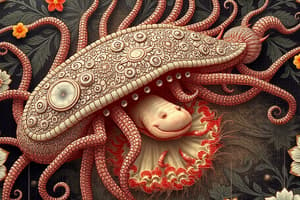Podcast
Questions and Answers
Which characteristic is unique to certain groups within the lophotrochozoans?
Which characteristic is unique to certain groups within the lophotrochozoans?
- Body segmentation
- Bilateral symmetry
- Lophophore structures (correct)
- Presence of a coelom
In which phylum are animals characterized as acoelomate with no true body cavity?
In which phylum are animals characterized as acoelomate with no true body cavity?
- Platyhelminthes (correct)
- Mollusca
- Entoprocta
- Annelida
What type of feeding strategy is most commonly observed across different phyla of lophotrochozoans?
What type of feeding strategy is most commonly observed across different phyla of lophotrochozoans?
- Detritivory
- Filter feeding (correct)
- Predation only
- Herbivory
Which group shows more complex organization in their organ systems?
Which group shows more complex organization in their organ systems?
What type of locomotion is characteristic of some lophotrochozoans?
What type of locomotion is characteristic of some lophotrochozoans?
What is a defining characteristic of Phylum Platyhelminthes?
What is a defining characteristic of Phylum Platyhelminthes?
Which of the following is a characteristic exclusive to Phylum Annelida?
Which of the following is a characteristic exclusive to Phylum Annelida?
What distinguishes Phylum Mollusca from the other lophotrochozoan phyla?
What distinguishes Phylum Mollusca from the other lophotrochozoan phyla?
Which of the following phyla exhibits a true coelom?
Which of the following phyla exhibits a true coelom?
What feature is specific to Phylum Brachiopoda?
What feature is specific to Phylum Brachiopoda?
Which of the following is TRUE about Phylum Bryozoa?
Which of the following is TRUE about Phylum Bryozoa?
Which phylum is NOT characterized by a trochophore larva?
Which phylum is NOT characterized by a trochophore larva?
Which characteristic is unique to Phylum Annelida compared to other lophotrochozoans?
Which characteristic is unique to Phylum Annelida compared to other lophotrochozoans?
Flashcards
Entoprocts
Entoprocts
Tiny, often colonial marine creatures in the Phylum Entoprocta, typically microscopic and resembling moss-like growths.
Lophophore
Lophophore
A specialized feeding structure found in some lophotrochozoan animals (like entoprocts), used to collect food particles from the water.
Body Symmetry in Lophotrochozoans
Body Symmetry in Lophotrochozoans
Lophotrochozoan animals have bilateral symmetry, but different groups exhibit varying degrees of segmentation (like annelids).
Feeding Strategies in Lophotrochozoans
Feeding Strategies in Lophotrochozoans
Signup and view all the flashcards
Lophotrochozoan Complexity
Lophotrochozoan Complexity
Signup and view all the flashcards
Lophotrochozoa
Lophotrochozoa
Signup and view all the flashcards
Trochophore larva
Trochophore larva
Signup and view all the flashcards
Platyhelminthes
Platyhelminthes
Signup and view all the flashcards
Annelida
Annelida
Signup and view all the flashcards
Mollusca
Mollusca
Signup and view all the flashcards
Brachiopoda
Brachiopoda
Signup and view all the flashcards
Bryozoa
Bryozoa
Signup and view all the flashcards
Study Notes
Lophotrochozoans: Phyla Characteristics
-
Lophotrochozoa is a large group of bilaterian animals, characterized by a trochophore larva stage in some phyla. This stage is a free-swimming larval form, typically featuring a band of cilia around the middle.
-
The defining characteristic of lophotrochozoans is their developmental pattern, involving a trochophore larva stage.
-
Many, but not all, lophotrochozoans have a trochophore larva; some have evolved alternative developmental pathways. A lophophore, a ring of ciliated tentacles around the mouth, is present in some species, but not all.
-
Phylum Platyhelminthes (Flatworms):
- Dorsoventrally flattened body plan; acoelomate body cavity.
- Lack specialized circulatory or respiratory systems.
- Simple nervous system, often with a pair of ganglia and nerve cords.
- Diverse feeding strategies, including parasitic and free-living predatory forms.
- Lack a coelom (true body cavity).
-
Phylum Annelida (Segmented Worms):
- Segmented bodies, a characteristic absent in other lophotrochozoans.
- Possess a coelom, often divided into segments.
- Circular muscle arrangement in the body.
- Typically, a closed circulatory system.
- Some are free-living, others are parasitic.
-
Phylum Mollusca (Mollusks):
- Diverse group, ranging from clams and snails to octopuses and squids.
- Soft body, often with a muscular foot.
- Often with a shell (hard component in some).
- A mantle that secretes the shell and other structures. Visceral mass containing most organs.
- Varied feeding adaptations across different groups.
-
Phylum Brachiopoda (Brachiopods):
- Two-part shell, dorsal and ventral (opposite to bivalve mollusks).
- Typically sessile filter feeders.
- Primarily marine.
- Clearly possess a lophophore feeding apparatus.
-
Phylum Bryozoa (Bryozoans):
- Colonial animals.
- Often with a lophophore for feeding.
- Often marine.
- Extremely small.
-
Phylum Entoprocta (Entoprocts):
- Very small, often microscopic.
- Colonial, resembling moss-like growth.
- Characteristically possess a lophophore.
Key Differences Amongst Lophotrochozoans
-
Body symmetry: All bilaterally symmetrical; varying degrees of segmentation (primarily in Annelids). Lophophore structures are specialized features in certain groups.
-
Body cavities: Acoelomate in Platyhelminthes; coelomate in Annelids and most Mollusks; variations exist among other phyla.
-
Feeding strategies: Diverse, including filter feeding and predation, prevalent across various phyla.
-
Locomotion: Diverse, ranging from sessile filter feeders to active predators and free-living crawlers.
-
Complexity of organ systems: Platyhelminthes have simple organ systems, while Annelids (and some mollusks) demonstrate complex organization.
-
The diversity of lophotrochozoans reflects intricate evolutionary adaptations, resulting in various forms and lifestyles. Understanding their defining characteristics is crucial for classification and exploring their evolutionary relationships.
Studying That Suits You
Use AI to generate personalized quizzes and flashcards to suit your learning preferences.
Description
Explore the fascinating characteristics of Lophotrochozoans and their unique larval stages. This quiz covers the defining traits of various phyla, particularly focusing on Platyhelminthes, known for their flat body plan. Test your understanding of their developmental patterns and anatomical features.



